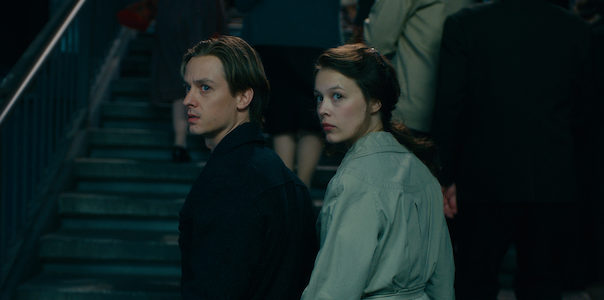
ReelBob: ‘Never Look Away’ ★★★½
By Bob Bloom
What inspires art? What forces or memories in an individual’s psyche trigger the need to create, to express a particular point of view, to the world?
That is the central question of “Never Look Away,” a three-hour-plus historical drama that follows nearly 30 years in the life of Kurt Barnet (Tom Schilling), a painter loosely modeled on Gerhard Richter, a renowned 20th-century visual artist.
The movie’s canvas is large, beginning in 1937 Nazi Germany and ending in 1967, a few years after the construction of the Berlin Wall.
The movie opens with a young Kurt and his aunt, Elisabeth, at an exhibition of “decadent art” in Dresden. In front of the crowd, a Nazi curator derides the works and maligns those who painted them as mentally ill or perverse.
Elisabeth later confides to her little nephew that she likes the paintings. She also tells him that the truth, no matter its form, is beautiful, and that one should never look away from the truth.
The free-spirited Elisabeth (Saskia Rosendahl) soon becomes the victim of the Nazi obsession with racial, mental and genetic purity in the person of gynecologist Professor Carl Seeband (Sebastian Koch).
After a few scenes that show the toll the war took on Germany and Kurt’s family, we find the teenage Kurt in East Germany, where his father, a former schoolteacher, cannot get a job because of his past affiliation with the Nazi Party. (To continue teaching, he had to join the party — even though he secretly opposed the Nazis.)
The movie again jumps a few years, when Kurt is now a student at an East German art institute, where artistic expression is discouraged, and students are taught “Socialist realism” — works that glamourize Communism and the proletariat.
At the school, Kurt meets another student, Elisabeth (Paula Beer), who reminds him of his aunt. He calls her Ellie, the nickname her father uses. Ellie’s father is Carl Seeband, the same ex-Nazi official who condemned Kurt’s beloved aunt.
None of this, of course, is known to Kurt or Ellie, as Seeband, still a noted gynecologist, has covered up his past very neatly.
Outwardly, Seeband is polite to Kurt for Ellie’s sake; privately, he believes Kurt is unfit for his daughter.
As portrayed by Koch, Seeband is a cold, manipulative monster. He is soft spoken but has the ability to use words like daggers that cut and maim.
He is quietly ruthless, using his medical expertise to further his own ends rather than aid humanity.
Eventually, despite Seeband’s resistance, Kurt and Ellie marry. Later, Seeband, with his wife, is forced to flee to the West.
Kurt and Ellie stay in East Germany, where Kurt paints and is commissioned to create a mural extolling the working class. But he feels dead inside because he cannot express his own artistic visions.
Soon, he convinces Ellie to defect with him to the West, which they do in 1961 when travel between the two Germanys was simpler in those pre-wall years.
As played by Schilling, Kurt is an artist seeking his own style and form of expression. Schilling’s eyes always seem to be studying people and objects, forms and shapes. He is observant, always seeing the beauty in everyday, mundane objects — and in people, as well.
After many attempts, Kurt finds his calling, using newspaper clippings and old family photographs — creating a visual art form that was at the vanguard of a new movement in contemporary art.
You’d think with its lengthy running time, “Never Look Away” would sag at times. Though, despite a dearth of action, writer-director Florian Henckel von Donnersmarck holds your interest because of the tension he intersperses throughout the movie.
We know the links that seem to bind Kurt and Seeband and wait for one or the other to realize the connection.
The interactions of the main characters also create suspense. Early on, we know that Ellie’s mother, Martha (Ina Weisse), has discovered the true relationship between Kurt and her daughter; yet she says nothing to her husband — and seems to encourage the young lovers.
Seeband, while not overtly objecting to the marriage, looks down on Kurt and disapproves of his chosen calling.
“Never Look Away,” one of the five nominees for the foreign-language film Academy Award, may be a bit too self-conscious. Von Donnersmarck’s thesis — that obstacles can only delay, not deter, an artist — does come to fruition, and he takes his time peeling back the layers to reach the core of his argument. They may not be as sharp as he imagined, but they do bear up to scrutiny.
His movie, nonetheless, is tantalizing and mesmerizing. Moments arise where you will feel mentally — and, perhaps, physically — exhausted, but hard as you try, you can never look away from this experience.
I am a founding member of the Indiana Film Journalists Association. My reviews appear at ReelBob (reelbob.com) and Rottentomatoes (www.rottentomatoes.com). I also review Blu-rays and DVDs. I can be reached by email at bobbloomjc@gmail.com or on Twitter @ReelBobBloom. Links to my reviews can be found on Facebook, Twitter and LinkedIn.
NEVER LOOK AWAY
3½ stars out of 4
(R), sexual content, nudity, violent images, language